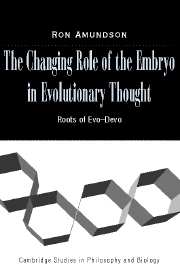Book contents
- Frontmatter
- Contents
- Acknowledgments
- 1 Introduction
- PART I DARWIN'S CENTURY: BEYOND THE ESSENTIALISM STORY
- PART II NEO-DARWIN'S CENTURY: EXPLAINING THE ABSENCE AND THE REAPPEARANCE OF DEVELOPMENT IN EVOLUTIONARY THOUGHT
- 7 The Invention of Heredity
- 8 Basics of the Evolutionary Synthesis
- 9 Structuralist Reactions to the Synthesis
- 10 The Synthesis Matures
- 11 Recent Debates and the Continuing Tension
- References
- Index
8 - Basics of the Evolutionary Synthesis
Published online by Cambridge University Press: 05 June 2012
- Frontmatter
- Contents
- Acknowledgments
- 1 Introduction
- PART I DARWIN'S CENTURY: BEYOND THE ESSENTIALISM STORY
- PART II NEO-DARWIN'S CENTURY: EXPLAINING THE ABSENCE AND THE REAPPEARANCE OF DEVELOPMENT IN EVOLUTIONARY THOUGHT
- 7 The Invention of Heredity
- 8 Basics of the Evolutionary Synthesis
- 9 Structuralist Reactions to the Synthesis
- 10 The Synthesis Matures
- 11 Recent Debates and the Continuing Tension
- References
- Index
Summary
A LONG STORY MADE SHORT
A purpose of this book is to examine why development has so little role in twentieth-century neo-Darwinian evolutionary theory, even though it played a large role in earlier evolutionary thought. It is now possible to make that long story short.
The Short Story of the Disappearance of Development From Evolution
Ever since Darwin, it has been recognized that evolution is an interplay of heredity and adaptation. During the nineteenth century, heredity was itself considered to be an aspect of the embryological development of the individual organism. Partly for this reason, nineteenth-century evolutionary concepts intertwined embryology with heredity and adaptation. Early in the twentieth century, the Mendelian–chromosomal theory of heredity was devised. According to the MCTH, heredity is completely distinct from embryological development. In the 1930s and 1940s, the MCTH was combined with population genetics and other fields to form the Evolutionary Synthesis. Development remained irrelevant to heredity, and no additional reason was found to justify the study of development by Synthesis evolutionists. The discovery that development is irrelevant to evolution was no more problematic than the discovery that astrology is irrelevant to disease.
There is a large grain of truth in the Short Story, but it is not the whole truth. We need to examine more closely the origins of the Evolutionary Synthesis, and the reactions to it by advocates of the study of development.
Information
- Type
- Chapter
- Information
- The Changing Role of the Embryo in Evolutionary ThoughtRoots of Evo-Devo, pp. 159 - 168Publisher: Cambridge University PressPrint publication year: 2005
